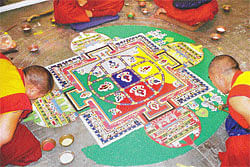Vibrant expressions of art

Art in any form is closely associated with aesthetics and even commerce, in that some forms of art have a price and are sold or auctioned. But art, purely as a form of spiritualism and philosophy, is a rarity. The sand mandala or cosmogram of Tibetan Buddhist tradition is one such rare art form.
Making mandalas of coloured sand is a tradition of tantric Buddhism. In Tibetan, this art is called dul-tson-kyil-khor, which literally means “mandala of coloured powders”. Millions of grains of sand of different colours are painstakingly laid into place on a flat platform over a period of days or weeks. The colours are usually made with naturally coloured sand, crushed gypsum (white), yellow ochre, red sandstone, charcoal, and a mixture of charcoal and gypsum (blue). The exquisite mandala which finally emerges from the laborious work symbolises the impermanence of all that exists. Powdered and coloured stone is also used wherever it is available. In ancient times, powdered precious and semi-precious gems were also used. Thus lapis-lazuli would be used for the blues, rubies for the reds, and so on.
This art follows a traditional and prescribed iconography that includes geometric shapes and a multitude of ancient spiritual symbols. The sand-painted mandala is used as a tool for re-consecrating the earth and its inhabitants. The subject of a mandala are of many types. In general, all mandalas have outer, inner and sacred meanings. On the outer level they represent the world in its divine form; on the inner level they represent a map by which the ordinary human mind is transformed into enlightened mind; and on the secret level they depict the primordially perfect balance of the subtle energies of the body and the clear light dimension of the mind. The creation of a sand painting is said to effect a purification and healing on these three levels.
Before laying down the sand, the monks assigned to the project will draw geometric measurements associated with the mandala. The sand granules are then applied using small tubes, conical funnels, and scrapers, until the desired pattern over-top is achieved.
Usually, a team of monks work together on the project, creating one section of the diagram at a time, working from the centre outwards.
Every tantric system has its own mandala, and thus each one symbolises a particular existential and spiritual approach. For example, that of the Bodhisattva Avalokiteshvara symbolises compassion as a central focus of the spiritual experience; that of Manjushri takes wisdom as the central focus; and that of Vajrapani emphasises the need for courage and strength in the quest for sacred knowledge.
Other important tantric systems are those of the Medicine Buddha and Amitayus Buddha.
Amitayus (Amitabha) is the principal Buddha to overcome the power that death and ignorance have over us. These are created whenever a need for the healing of the environment and living beings is felt.
The Kalachakra Mandala has 722 deities portrayed within the complex structure and geometry of the mandala itself. Other smaller mandalas, like the one attributed to Vajrabhairava contain sufficiently fewer deities and require less geometry, but still take several days to complete. Like all mandalas, these are meant as two-dimensional representations of what is supposed to be a three-dimensional environment.
A sand mandala is ritualistically destroyed once it has been completed and its accompanying ceremonies and viewing are finished to symbolise the Buddhist doctrinal belief in the transitory nature of material life. The destruction of a sand mandala is also highly ceremonial. Even the deity syllables are removed in a specific order, along with the rest of the geometry, until at last the mandala has been dismantled. The sand is collected in a jar which is then wrapped in silk and transported to a river (or any place with moving water), where it is released back into nature. The belief is that the waters carry the healing energies throughout the world.
Sand mandalas are prepared by monastries of various tantric traditions. In Karnataka, the monks of Gyudmey Monastery prepare sand mandalas. Gyudmey Tantric University was established in 1433 by Jetsun Sherab Senge, one of the most prominent disciples of Je-Tsongkhapa, the founder of Gelukpa Tradition of Tibetan Buddhism
After coming into exile in 1959, following Chinese occupation, Gyudmey Tantric University, with guidance from Dalai Lama, was re-established at Tibetan Rabgyeling Settlement, Hunsur in Karnataka in 1972. With an initial sangha of 180 monks, today, Gyudmey Tantric University has more than 680 scholarly monks studying in it.
Deccan Herald is on WhatsApp Channels| Join now for Breaking News & Editor's Picks